
(by Michelangelo)
by John P. Pratt
23 Dec 2014, Trumpets (UH), Winter (H)
©2014 by John P. Pratt. All rights Reserved. Reprinted in Meridian Magazine (19 Apr 2015)
| 1. Venus Calendar |
| 2. Twelve Steps to Adam |
| 2.1 Resurrection of Christ |
| 2.2 King Jeconiah Captive |
| 2.3 Jubilee Year |
| 2.4 Birth of Christ |
| 2.5 Crossing River Jordan |
| 2.6 The Exodus |
| 2.7 Birth of Jacob |
| 2.8 Eber and Peleg |
| 2.9 Baptism of Christ |
| 2.10 Great Flood |
| 2.11 Jared |
| 2.12 Adam |
| 3. Conclusion |
| Notes |
Over the past three decades, fourteen sacred calendars have been discovered which have been used to create a chronology from Adam through the present day. Many of the key religious events of history occurred on dates which are holy days on many of those calendars simultaneously. Each calendar provides one thread of testimony, but together the threads are woven into a strong rope which provides compelling evidence of the overall accuracy of the chronology.
One problem has been that it has now become so complex that someone new to the concept cannot go to any one place and see the network of proof of the accuracy of these dates. Any one date can be looked up on the Religious Chronology page of my website, which provides links to the articles in which that date was discussed. Recently Ed J. Pinegar, friend and author, asked me to write a short overview of how the interlinking sacred calendar date system works without the reader having to learn all of the details of even one calendar. This article is my response, which has been long needed to show the principles. It requires only a little knowledge of just one sacred calendar: the Venus Calendar. Armed with that and only one holy day from the Hebrew Calendar, a chronology framework from Christ back to Adam can be built in twelve steps.
 |
The method is to start with two firm anchor dates, known from historical records. Those two dates are chosen because they also coincide with holy days on the Venus Calendar. Then one can link those dates to other events separated by known Venus Calendar intervals which realign that calendar on the same holy day. Two such periods are 40 years and 430 years. The only knowledge of the Hebrew Calendar needed for this article is that it has a sacred day in the spring called Passover which begins a seven-day holy week. Many of the derived dates used in this article occur not only on a Venus Calendar holy day, but also on Passover, forming a double witness. Passovers are calculated using the Perpetual Hebrew Calendar because it includes minor corrections required to be accurate over long time periods. Now let us look first at five holy days on the Venus Calendar and then discuss twelve steps from Christ to Adam.
The Venus Calendar keeps track of where the planet Venus is in the sky. Venus sometimes appears in the western sky as the Evening Star, and other times in the eastern sky as the Morning Star.
The cycle of Venus represents the cycle of life, especially that of the Savior (Rev. 22:16). There are nine key orbital points of the planet which correspond to nine steps of life. All nine of those coincided with nine different sacred events in His life.[1]
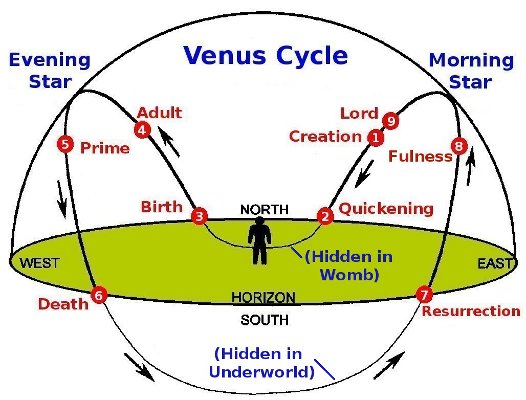 |
At each of those holy points there are two consecutive holy days. One represents the last day of the last phase and at the same time the "zeroth day" of the next (D&C 29:30). It is followed by the first day of the next phase. For the purposes of this paper, an event occurring on either the zeroth or first day will simply be said to be occurring on the associated holy day. In this paper, only five of the nine holy days are needed. They are the five most important, being those with the odd numbers (associated with entering light rather than darkness): Creation, Birth, Prime, Resurrection, and Lord.
The Venus Calendar tracks only the average position of the planet in the heavens. It has a fixed pattern which remains unchanged for about twenty years. At that point the calendar is adjusted with some "leap days" to keep it tracking the planet better. Those adjustments also follow a fixed format. This is mentioned so that the reader understands that the calendar has a fixed format and cannot be adjusted at will to fit desired historical milestones. Hopefully, that is all that is needed to understand this article. More details can be found in an earlier article.[2]
As explained above, the first two steps of the method select well established dates from history which are also holy days on the Venus Calendar. All dates are given on our modern Gregorian Calendar (the one used worldwide today), even though it was not in use back in those times. Let us begin with what the sacred calendars testify is the most important and holy date in history: the Resurrection of Jesus Christ.
 |
Careful readings of the Gospels also show that Passover for the Judeans fell on Saturday that spring, on the day after the Crucifixion. Thus it was important to get His body off the cross and placed in the sepulcher before sunset on Friday, which would begin both Passover and the weekly sabbath. The Hebrew day begins after sunset (or 6 pm). Putting those two facts together implies that the Lamb of God was sacrificed at the same time the lambs were sacrificed which would be eaten that same evening as part of the sacred Passover meal. The day of the week of Passover is also a big clue to the year because Passover can fall on different days of the week.
Jesus said many times in his ministry that he would rise on the "third day" from his death. People at that time counted inclusively, which means the starting event is counted as the first. That is, the Friday of His death was the first day, Saturday the second, and He rose on Sunday, the third day.
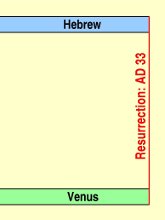 |
Thus, our first anchor date is that of the Resurrection: Sun 3 Apr AD 33. If all we knew about Jesus were facts about his ministry and death, there would probably be no dispute about this date. However, because of confusion about the time of Jesus' birth, most scholars have rejected the testimony of the scriptures and believe that the Resurrection was three years earlier. For this article, let us just believe the scriptural witness and accept the date of the Resurrection as an accurate date to which a true chronology can be anchored. That is what this author did three decades ago when his first article was published expressly to establish that as a fixed date. Readers can get further details by reading it.[3]
That anchor date for the Resurrection occurred precisely on Resurrection Day on the Venus Calendar. There are 585 days in the Venus Cycle, and the Resurrection of Jesus Christ occurred on the very day of the resurrection of the planet Venus as the bright Morning Star. It was the discovery of that unlikely alignment that initially induced this researcher to begin looking for other religious events on both Hebrew and Venus holy days.
For the purposes of this paper, note that this anchor date falls on a holy day on both the Hebrew and Venus Calendars. Figure 2 shows the last part of two timelines ending with the Resurrection, which will be extended back to Adam. The upper bar represents the Hebrew Calendar, the lower bar shows holy days on the Venus Calendar, and the events are shown on vertical lines connecting them. If the event line connects to the upper bar, it means that the event fell on a known day of Passover week (in this case the second day). If it connects to the bottom bar, it occurred on one of the five pairs of holy dates on the Venus Calendar discussed above.
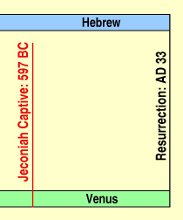 |
That day was Sat 10 Mar 597 BC, which was New Year's Day on the Hebrew Calendar. On the Venus Calendar it was "Birth", the day when Venus is born as it first rises as the Evening Star. It is shown in Figure 3 as connected to the Venus timeline (being a holy day), but not to the Hebrew timeline because it did not fall on Passover. As these timelines are built, the new additions from each step are shown in red, with former results in black.
The law that God gave to Moses included counting years a special way. First, they were to be counted by sevens, like days of a week. In fact, the seventh year was to be a sabbath year, even as was the seventh day of the week. Then the weeks of seven years were also to be counted by jubilees of seven times seven years. The fiftieth year after a jubilee of 49 years was called the "jubilee year" (Lev. 25:8,10). It was also the first year of the next set of set of 49 years. For our purposes it is only necessary to know that years are counted in sets of 49 called jubilees.
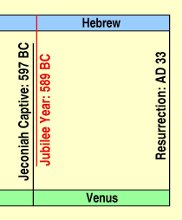 |
The third step of the chronology is simply to identify that jubilee year. Counting from Zedekiah's first year in 597 BC, his ninth year began in the spring of 589 BC. Nebuchadnezzar's siege began in the winter (December) of Zedekiah's ninth year, three months after the end of the jubilee year. The jubilee year was from the fall of 590 BC to the fall of 589 BC. For this date, only the year is necessary. For more details, an entire article was devoted to establishing this point.[5]
The fourth event date needed is that of the birth of Jesus Christ. This date has eluded scholars because there is not enough information in the scriptures to determine it. The approximate year is made clear by Luke who states that Jesus "began to be about thirty" when he was baptized in AD 29 (Luke 3:23). That implies His birth was in about 2-1 BC (there was no year 0 BC). Most modern scholars place His birth much earlier, in 6-4 BC because of what some records say about death of King Herod the Great. But again, just sticking with the Biblical account, one would expect the year to be 2-1 BC. Indeed, the traditional date for Christmas is 25 Dec 1 BC.
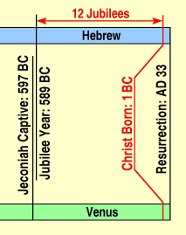 |
The jubilee was given in the law of Moses to point toward Christ, just as were all things in the law of Moses (Gal. 3:24). The principal concept of the jubilee year was to proclaim liberty (Lev. 25:10). Jesus declared that he came to proclaim liberty, quoting (Isa. 61:1-2), where it is called it the "acceptable year" (Luke 4:17-21).
Thus, we would expect the jubilee to come either at his birth, or when he quoted that scripture, or perhaps at the Passover of his death when He fulfilled the promise by proclaiming liberty to the captives in spirit prison (D&C 138:18). Looking at when the jubilee falls during the life of the Savior, we find that twelve jubilees after the one in the days of Zedekiah bring us to the year 1 BC as a jubilee year. The next one would come 49 years later, after His death. So the best interpretation appears to be that Christ would be born in a jubilee year.
As for the day of his birth, a careful reading of the law of Moses shows that Passover was designed to be the "birthday party" of the Savior.[6] The Passover feast, eaten on the evening preceding (beginning) the holy day Passover, was the Savior's birthday feast. It also celebrated the birth of the nation of Israel, which was born on the Passover day on which they escaped from bondage in Egypt.
Passover that year occurred on Thu 6 Apr 1 BC, with Jesus being born the preceding evening right when the Passover Feast would have been eaten. It turns out the evening of the feast occurred on the holy day "Lord" on the Venus Calendar. That is His special day, He being the Lord of all. So both His day of birth as well as His day of Resurrection were bull's-eyes on the Venus Calendar. That is, they were both not just on any holy day, but the one day in 585 most suited for the event.
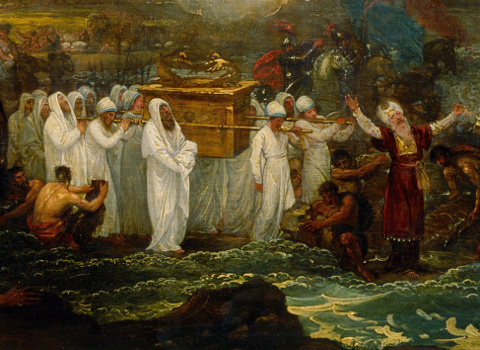 |
Thus, the seventeen jubilees do not just refer to any set of 17 x 49 years, but to a period which both began and ended in a jubilee year. That is, we have just seen that Judah fell to Nebuchadnezzar just after a jubilee year, and Israel entered the Promised Land at the beginning of counting jubilees. Remember that the first year of a jubilee is also a jubilee year, being the fiftieth year of the preceding jubilee.
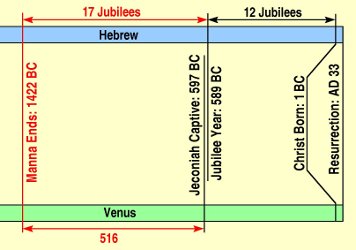 |
Manna, the bread from heaven, represented Jesus Christ (John 6:32,35). The day on which it stopped was on the Friday before Easter. That is, it was on Good Friday, the day on which Jesus, the true Bread from Heaven, was also taken away. That is another witness that the Savior was crucified on a Friday.
That day was the holy day for Birth on the Venus Calendar. Thus the next step in the chronology is the day the manna ceased, occurring both during the Passover week and also on a holy day on the Venus Calendar. In Figure 6 that day is shown on both timelines. The number 516 below the Venus timeline means that it was exactly 516 Venus cycles from the Venus day "Birth" when the manna stopped to the Venus day "Birth" when King Jeconiah was taken captive. Where arrows are shown between dates, it is an exact number of Venus Cycles or Hebrew years (counting years from Passover to Passover).
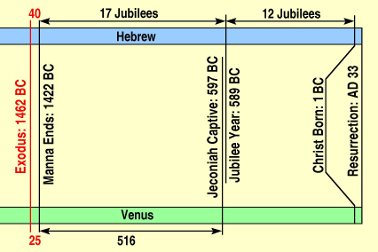 |
After the Exodus, the children of Israel wandered for almost exactly forty years in the wilderness. It turns out that 40 years are within a few days of being 25 Venus cycles. Counting back exactly 25 Venus cycles from the day the manna ceased brings us to Tue 14 Apr 1462 BC. That evening began the night of the Parting of the Red Sea on the Last Day of Passover. The Exodus from Egypt began on Passover, then three days later Pharaoh awakened to the fact that he'd set all the slaves free and began to chase them, and on the seventh and Last Day of Passover, the Red Sea was parted so they could escape into the wilderness. On the Venus Calendar it was the day of Birth, very appropriate (another bull's-eye) for the birth of Israel as a nation as it broke through the water and was delivered from the womb of Egypt.
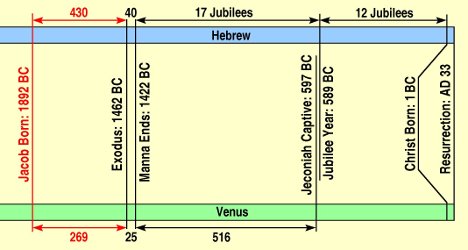 |
It turns out that 430 years is also an interval in which the year lines up with Venus, being 269 Venus cycles. Going back exactly 430 years to the day of Passover that year, brings us to a perfect alignment with Venus. That is, instead of Venus aligning on the Last Day of Passover, this time the day of Birth for Venus falls exactly on Passover. Thus we have two witnesses agreeing on the importance of this date, which indeed works perfectly as the birth date of Jacob: Wed 20 Mar 1892 BC after sunset. Jacob's birth did not occur on a random holy day of Venus, but on the very day representing birth. That's yet another bull's-eye!
The number 430 shows up again in those boring pages of the Book of Genesis that tell how long the ancient patriarchs lived, and how old they were when they had their principal son. In the case of Eber, for whom the Hebrews are named, we are told that he lived 430 years after the birth of his son Peleg (Gen. 11:17). This is starting to get pretty far back because Peleg was born only about a century after the Great Flood. Eber lived so long that he knew and taught Jacob.
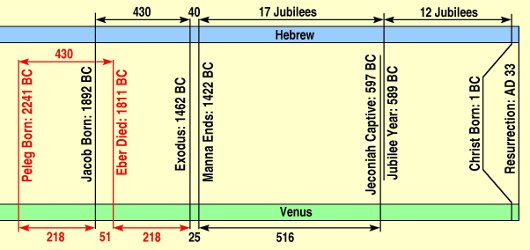 |
There is great wisdom hidden in what appear to be the most boring parts of the Bible. Genesis is not a bunch of campfire stories as is so often taught by modern faithless scholars. But the best is yet to come!
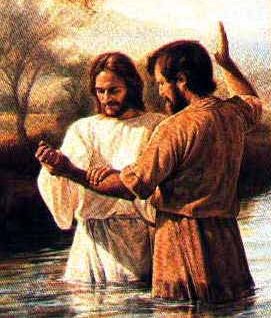 |
The Savior was baptized on a day when many others were also. It would most likely have been a holy day on the Hebrew Calendar, at least a sabbath day, when many would have been off work and free to go to John the Baptist in the wilderness. But there is one day of the Hebrew year which is the perfect day for baptism. When Moses was given the law, there were six feast days and one fast day designated. That fast day is called the Day of Atonement. It is the holiest day of the Hebrew year. It is the day to become reconciled with God.
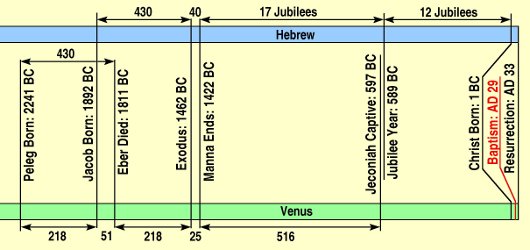 |
On the Venus Calendar, that was the day Prime, when the planet is fully mature and near its brightest point. That is the day symbolic of being born again, which is what baptism symbolizes. By "born again" is meant allowing the natural (evil) man to be replaced by becoming reconciled to God, choosing to obey Him. Thus, both the Venus and Hebrew holy days are bull's-eyes, where the event matches the holy day symbolism. That date has since been verified as being a holy day on ten of the fourteen known sacred calendars, so it is no longer in question.
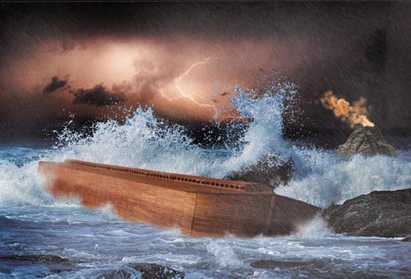 |
In earlier papers every one of those dates has been discussed and shown to have been a meaningful holy day on various calendars.[9] For the purpose of this article only one date is needed: the day Noah began to load the ark, being one week before the Flood began. That day is dubbed Noah's Ark Day in my articles.
Because the day on which the Flood began is given to the very day (Gen. 7:11) it is only necessary to count back years from the birth of Peleg to find that year (Gen 11:10-16).
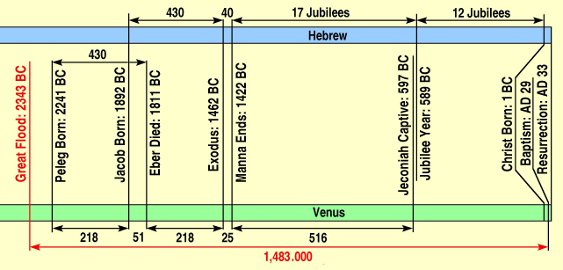 |
Is that important to know? Many inspired commentators have taught that the Great Flood was the baptism of the earth, and that baptism is to be done by immersion ("baptize" is Greek for "immerse"). This appears to be a direct confirmation of that symbolism.
Now we come to what appears to me to be one of the most amazing discoveries of the hand of God. Readers are asked to ponder these facts carefully and ask themselves if it could have all happened by random chance.
Each of the ten patriarchs from Adam to Noah has a name with special meaning in Hebrew. This article focuses on only one of them: Jared, the father of the great prophet Enoch. The name Jared means to "descend". The word is directly related to baptism, so much so that it appears that Jared was named to symbolize baptism.
Jared's birth and death dates can be determined from the dates given in the Bible and using other sacred calendar patterns.[10] It turns out that both his birth date (Mon 30 May 3540 BC) and death date (Mon 3 Nov 2578 BC) occurred when Venus was precisely at "Prime". That is the same day representing baptism as at the Great Flood, his death being exactly 147 Venus cycles before Noah's Ark Day. It was also the same Venus day as Savior's Baptism.
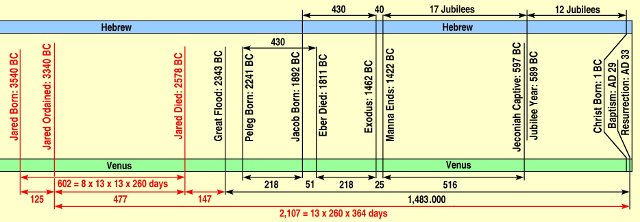 |
But there's more! In what might be the strangest scripture of all, in modern revelation the Lord has given the times of the ordinations of all of the patriarchs from Adam to Noah. Who could possibly care about such apparently unnecessary detail? And the strangest verse of all is where we are told that one of those prophets was 496 years and 7 days old when he was ordained (D&C 107:46). Who really cares about those extra seven days? Stop and ponder for a moment, why would the Lord reveal that to us?
It turns out the Lord revealed just the minimum to allow the exact day of each ordination to be determined.[11] In the case of Jared, he was ordained at the age of 200 on Sat 6 Apr 3340 BC. That day also was the day Prime on the Venus Calendar (exactly 125 Venus cycles from his birth), so his entire life seems symbolic of baptism.
The final amazing fact is that the number of days from the ordination of Jared to the baptism of Jesus was 13 x 260 x 364 days. It turns out that another sacred calendar has exactly 364 days every year (no leap days ever), being the Uniform Enoch Calendar. So his ordination date is also the same as Christ's baptism date on the Sacred Round and the Enoch Calendar, both of which were on holy days. Similar things have been explained in other articles about the other patriarchs using the witnesses of many sacred calendars. To keep it simple for this article, we just looked at Jared and his vital dates on only one sacred calendar. Surely the foreknowledge and hand of God is evident to the reader in all of these calendar alignments.
The final step is to count back years from Jared to the point from which the beginning of Adam's mortal life of 930 years is reckoned. In my work that day is called the "Beginning of Mortality".
That day is clearly indicated on 12 of the 14 known sacred calendars to have been one of the holiest days in all of history. It was Sun 9 Apr 4001 BC, being Passover on the Hebrew Calendar. This makes a lot of sense symbolically. One of the features of Passover is that it is the time to leave and go into the wilderness, as the Israelites did at the Exodus from Egypt. The Book of Mormon prophet Lehi most likely left at Passover for his journey into the wilderness.[12] It is for this reason that the Beginning of Mortality in my articles is identified as when Adam and Eve were expelled from the Garden of Eden into the wilderness.
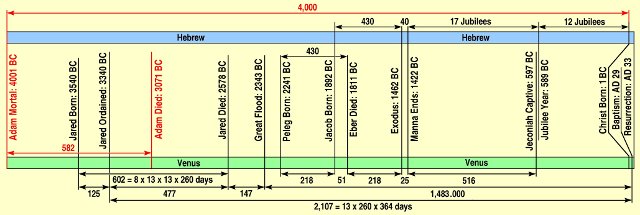 |
Moreover, the Beginning of Mortality was exactly 4,000 (Hebrew) years before the birth of Jesus Christ, to the very day (Passover). Again that shows incredibly high organization. A thousand years with man is one day with God (2 Peter 3:8), so Jesus came after exactly four of those long days.
Although not needed for the chronology, it may be interesting to note that the 930-year life of Adam also turns out to be an exact number (582) of Venus cycles. Figure 13 illustrates the complete chronology, where both the Hebrew and Venus calendars are tied into the system, both going all the way up to Christ. Surely all of this was planned out from the very Beginning.
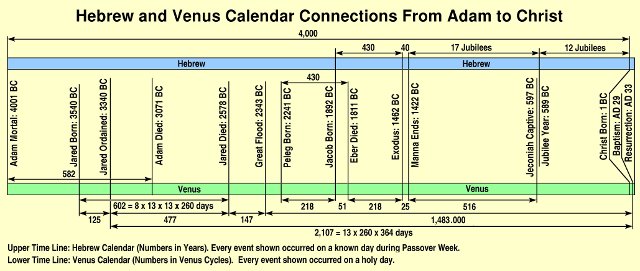 |
The meaning of God's words that He uses the lights in the heavens for days, years and set times (Gen 1:14) is now becoming clear to a degree not hitherto understood. Most of this article is based on an entire calendar associated with just one of those lights, the planet Venus. Its cycles are used to time events to the very day which can be separated by hundreds of years. We can learn the birth dates of ancient prophets, the very day the Great Flood began, and even that the interval between Adam and Eve leaving the Garden of Eden and the birth of Christ was 4,000 years to the very day.
The high degree of precision (to the very day) for every date and even the precise number of days in some of the longest intervals provides compelling evidence that the extreme ages ascribed to the antediluvian patriarchs are correct in terms of our years, that there was indeed a Great Flood, that Adam was a real person and the Fall a real event, and most importantly, that all of these events pointed to the birth and mission of the Savior and Redeemer, Jesus Christ.